

CEL Newsletter - Teacher Evaluation. Why are school districts choosing CEL's teacher evaluation model?
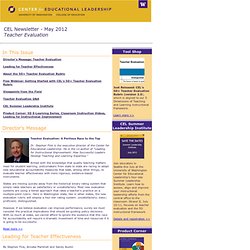
"We went through each framework, indicator by indicator to determine which one had the most indicators aligned with our beliefs and values about great teaching. The CEL model came out with a much higher percentage than the others. The fact that the UW has always been a problem-solving institution willing to work collaboratively with individuals and systems was a clear indicator of a framework authorship that would work with us and our unique needs as we progress through this process.
" -- Robert W. Manahan, Superintendent, Lake Chelan School District, Washington "After spending a year studying the CEL 5D framework we determined that this is the model we want to guide our work. " -- Mary Lou Bissett, Assistant Superintendent, Chehalis School District, Washington "A significant instructional improvement initiative in Kelso, Learning Targets, was well-aligned to the dimension Purpose. -- Robert R.
Teacher/Principal Evaluation Pilot. Was born out of Engrossed Second Substitute Senate Bill 6696 during the 2010 legislative session.
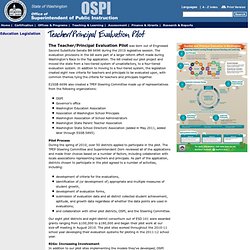
The evaluation provisions in the bill were part of a larger reform effort made during Washington's Race to the Top application. The bill created our pilot project and moved the state from a two-tiered system of unsatisfactory, to a four-tiered evaluation system. In addition to moving to a four-tiered system, the legislation created eight new criteria for teachers and principals to be evaluated upon, with common themes tying the criteria for teachers and principals together.
E2SSB 6696 also created a TPEP Steering Committee made up of representatives from the following organizations: Principal Landing. TPEP. Toolkit « Washington's Teacher/Principal Evaluation Pilot. Intro Video (1h 14m) Kick-Off Conference Introduction, Welcome and Introductions, E2SSB Framework for Evaluation and Workshop Goals, History of E2SSB 6696, Steering Committee Introductions, and Guest Practitioner Speakers (right click to download) Danielson Video: Assessing Effective Teaching Practices (1h 46m) Watch nationally renowned teacher evaluation expert Charlotte Danielson discuss the importance and challenges of assessing effective teacher practices.
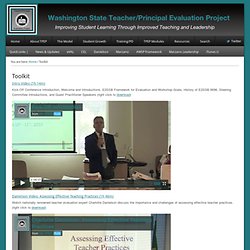
(right click to download) Charlotte Danielson Video: Designing Standards & Rubrics (21m) Following Charlotte’s first presentation on assessing effective teaching practices, this one covers designing effective standards and rubrics for teacher performance. AWSP’s Evaluating Principal Leadership in a Performance-Based School (PDF) (updated with rubrics 3/8/12) This AWSP document outlines the details of each of the eight E2SSB 6696 criteria which future principal evaluation models will be based on.
New vs. The Framework for Teaching. Research on the Framework for Teaching. For the Press Release: Measures of Effective Teaching Project Releases Final Research Report Ensuring Fair and Reliable Measures of Effective Teaching: Culminating Findings from the MET Project's Three-Year Study "In January 2013, the MET project released its third and final set of findings, which sought to answer three questions from practitioners and policy-makers: Can measures of effective teaching identify teachers who better help students learn?
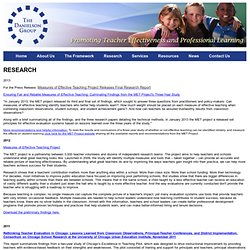
; How much weight should be placed on each measure of effective teaching when combining classroom observations, student surveys, and student achievement gains? ; And how can teachers be assured trustworthy results from classroom observations? ESD 112: Teacher and Principal Evaluation Project Background. TPEP Regional Implementation Grant Eight public school districts in Educational Service District 112 (ESD 112)—Camas, Castle Rock, Evergreen, Hockinson, Kelso, Ridgefield, Stevenson-Carson, and White Salmon—were selected to participate as a TPEP Regional Implementation Grant (RIG) districts for 2011-2012 & 2012-2013.
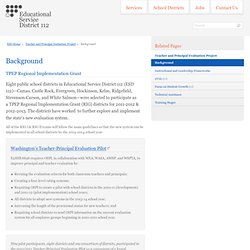
The districts have worked to further explore and implement the state's new evaluation system. All of the RIG I & RIG II teams will follow the same guidelines so that the new system can be implemented in all school districts by the 2013-2014 school year. Washington's Teacher-Principal Evaluation Pilot E2SSB 6696 requires OSPI, in collaboration with WEA, WASA, AWSP, and WSPTA, to improve principal and teacher evaluation by: The results from the work of the pilots in the 2010-2011 school year, along with the recommendations from the Superintendent of Public Instruction can be found in the July, 2011 Report to the Legislature. Washington's Teacher/Principal Evaluation Pilot. CEL’s 5D+ Teacher Evaluation Rubric 2.0. An evaluation system that truly builds the capacity of our teachers will lead to better practice, which ultimately will result in greater learning for all students.

Stephen Fink, Executive Director CEL’s Vision for Teacher Evaluation At the University of Washington’s Center for Educational Leadership (CEL), we believe that evaluation goes hand in hand with deepening the expertise of teachers to engage students in high quality learning while simultaneously increasing the expertise of school leaders to guide and support teachers in this improvement process. Our current and past work has touched 110 school districts in Washington alone since 2001.
As a local public university, we understand what works best in different settings in Washington and we are able to to work side-by-side with your district in a cost-effective manner.